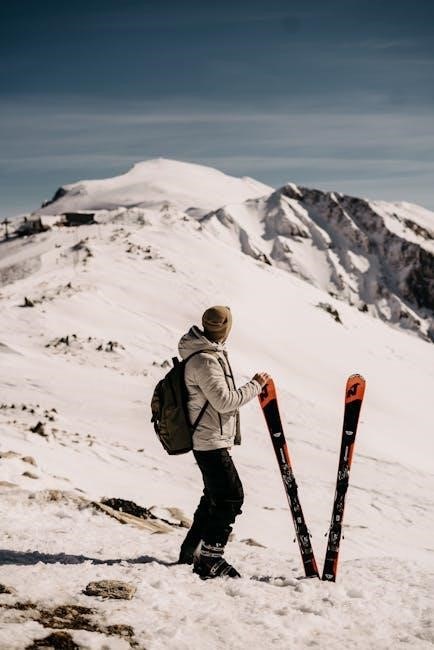Proper cross-country ski sizing ensures optimal performance, comfort, and control. Key factors include height, weight, skill level, and skiing style, with classic and skating skis differing in length.
Why Proper Ski Length Matters
Proper ski length is crucial for performance, stability, and control. Skis that are too long can be difficult to maneuver, while skis that are too short may lack stability. Correct length ensures efficient gliding, turning, and climbing. For beginners, shorter skis improve control and ease of use. Advanced skiers benefit from longer skis for speed and floatation in deep snow. Weight and height also influence ski length, with lighter skiers preferring shorter skis for agility. Ultimately, the right length enhances the overall skiing experience, making it safer and more enjoyable; Always consider skill level and skiing style when determining length.
Overview of Key Factors in Ski Sizing
Key factors in cross-country ski sizing include skier height, weight, skill level, and skiing style. Height determines base length, with adjustments for skill level. Weight affects floatation and stability, requiring longer skis for heavier skiers. Skill level influences length, with shorter skis for beginners and longer for experts. Skiing style differentiates between classic, skating, and backcountry skis, each with specific length and width requirements. Proper sizing ensures efficiency, control, and comfort, making the skiing experience enjoyable and safe. Accurate measurements and style considerations are essential for optimal performance.

Understanding the Importance of Proper Ski Sizing
Proper cross-country ski sizing enhances performance, comfort, and control. Correct length and width ensure efficient skiing, prevent fatigue, and maximize enjoyment on the trails.
How Ski Length Affects Performance
Ski length significantly impacts cross-country skiing performance. Longer skis enhance speed and efficiency, especially for advanced skiers, by maintaining glide and momentum. Shorter skis, however, offer better control and maneuverability, ideal for beginners or those navigating tight trails. Proper length ensures balanced weight distribution, reducing fatigue and improving technique. For lighter skiers, shorter skis provide easier handling, while heavier individuals benefit from longer skis for stability. Ski length also affects turning ease and overall stability at higher speeds. Choosing the right length maximizes performance, ensuring a enjoyable and efficient skiing experience. Always consider height, weight, and skill level when selecting ski length.
Comfort and Control: The Role of Ski Fit
Ski fit is crucial for both comfort and control in cross-country skiing. Properly sized skis ensure that the skier can maintain a balanced stance and maneuver effortlessly. A well-fitting ski aligns with the skier’s height, weight, and skiing style, reducing fatigue and enhancing performance. Comfort is essential for prolonged skiing sessions, as ill-fitting skis can lead to discomfort and poor technique. Control is equally vital, as it allows skiers to navigate various terrains confidently. The right fit ensures optimal energy transfer and glide efficiency, making every stroke more effective; Prioritizing ski fit guarantees a more enjoyable and efficient skiing experience.

Key Factors Influencing Cross-Country Ski Size
The size of cross-country skis is determined by the skier’s height, weight, skill level, and skiing style. These factors ensure optimal performance, comfort, and control.
Skier’s Height
Your height is a primary factor in determining cross-country ski length, as it directly affects stride mechanics and balance. Taller skiers typically require longer skis to maintain proper technique, while shorter skiers benefit from shorter skis for better control.
- Height helps determine the optimal ski length for efficient gliding and turning.
- Skiers with longer legs or torsos may need slightly longer skis, even if their overall height is average.
- For example, a skier around 170 cm (5’7″) might use skis between 160-190 cm, depending on other factors.
While height is crucial, it’s essential to consider weight and skill level alongside it for the best fit.
Skier’s Weight
Your weight plays a significant role in determining the ideal cross-country ski length, as it affects the ski’s ability to glide and provide floatation. Lighter skiers may prefer shorter skis for easier maneuverability, while heavier skiers benefit from longer skis for stability and control.
- Lighter skiers (under 120 lbs) often find shorter skis more responsive and easier to handle.
- Skiers of average weight (120-180 lbs) typically align with standard ski length recommendations.
- Heavier skiers (over 180 lbs) may need longer skis to maintain stability and prevent sinking in the snow.
Weight, combined with height and skill level, ensures the best fit for optimal performance and comfort.
Skill Level and Experience
Your skill level and experience significantly influence the ideal cross-country ski length. Beginners benefit from shorter skis, which are easier to control and maneuver, while more experienced skiers can handle longer skis for better performance.
- Beginners: Shorter skis (5-15 cm less than height) allow for easier turning and balance.
- Intermediate skiers: Skis closer to their height provide a balance of control and efficiency.
- Advanced skiers: Longer skis (equal to or slightly longer than height) enhance speed and glide.
Experience also plays a role, as skilled skiers can manage longer skis effectively, while less experienced skiers may find shorter skis more manageable. Balancing skill level with weight and height ensures the best fit for optimal performance and enjoyment. Ski length should align with your ability to maintain control and confidence on the trail.
Skiing Style (Classic vs. Skating vs. Backcountry)
Your skiing style directly impacts the ideal ski length. Classic skiing, which involves traditional striding, benefits from longer skis for stability and glide efficiency. Skating skis, used for high-speed, marathon-style skiing, are shorter and narrower to enhance agility and speed. Backcountry skis, designed for off-trail adventures, are wider and longer for better floatation in deep snow. Each style requires specific ski dimensions to optimize performance. Matching your ski length to your preferred style ensures a more enjoyable and efficient skiing experience. Proper sizing aligns with the demands of your skiing technique and terrain preferences.

How to Determine the Right Ski Length Based on Height
Start with your height and adjust based on skill level and skiing style. Beginners subtract more, while advanced skiers use skis closer to their height.
Beginners: Height Minus 10-15 cm
For beginners, cross-country skis should be 10-15 cm shorter than their height. This shorter length makes the skis easier to handle and maneuver, providing better control and stability. It allows for easier turning and stopping, which is crucial for learning proper technique. Shorter skis are also lighter, reducing fatigue and making it simpler to manage on flat or gently rolling terrain. This recommendation helps build confidence and coordination as new skiers develop their skills without feeling overwhelmed by overly long equipment.
This adjustment ensures the skis are manageable for those still mastering balance and movement, making the learning process more enjoyable and effective.
Advanced Skiers: Height Minus 5-10 cm
Advanced cross-country skiers benefit from skis that are 5-10 cm shorter than their height. This length provides a balance between speed, efficiency, and maneuverability, allowing for precise control and powerful strides. Skiers with more experience can handle slightly longer skis, which enhance glide and performance on various terrains. The reduced length compared to experts ensures easier turning and agility, while still maintaining the benefits of longer skis for speed and stability. This range is ideal for those who have mastered basic techniques and seek to optimize their performance without sacrificing control.
This adjustment supports advanced skiers in achieving a seamless blend of power and precision.
Expert Skiers: Ski Length Equals Body Height
For expert cross-country skiers, selecting skis that match their body height is ideal for maximizing performance and efficiency. This length provides optimal stability, power transfer, and glide, allowing for advanced techniques like powerful diagonal stride and double pole. Expert skiers benefit from the added control and precision, as full-height skis enable better tracking and reduced drag. This standard recommendation ensures skis are neither too short for speed nor too long for agility, making them perfect for experienced skiers who demand the highest level of performance on both groomed and ungroomed trails.
This approach allows experts to fully leverage their technique and strength for superior skiing.

Weight and Ski Length: A Practical Guide
Weight significantly impacts ski length, with lighter skiers preferring shorter skis for agility and heavier skiers opting for longer skis to maintain stability and floatation efficiently.
Lighter Weight: Shorter Skis for Better Maneuverability
Lighter skiers benefit from shorter cross-country skis, as this reduces swing weight and enhances maneuverability. Shorter skis are easier to control, allowing for quicker turns and precise movements. For skiers with a lower body weight, shorter skis also improve efficiency by reducing resistance in the snow. This makes climbing and maintaining speed on flat terrain more manageable. While shorter skis may sacrifice some glide, the trade-off in agility and ease of handling makes them ideal for lighter individuals seeking better responsiveness. Proper ski length ensures a balance between control and performance for skiers of all weights.
Average Weight: Standard Ski Length Recommendations
Skiers of average weight typically benefit from standard ski length recommendations, which balance speed, stability, and maneuverability. For cross-country skiing, a mid-range length is often ideal, as it provides efficient glide without sacrificing control. Average-weight skiers can follow general height-based guidelines, adjusting slightly based on skill level and skiing style. For most adults, this means skis ranging from 170 cm to 190 cm, depending on height. Proper fit ensures optimal performance, with skis that are neither too long nor too short. This balance allows for smooth, efficient skiing across various terrains and conditions.
Heavier Weight: Longer Skis for Stability and Float
Heavier skiers benefit from longer cross-country skis, which provide enhanced stability and floatation in snowy conditions. Longer skis distribute weight more evenly, reducing sinkage in deep snow and improving glide. This added length also boosts confidence and control, especially at higher speeds. For heavier skiers, skis that are 5-10 cm longer than standard recommendations are often ideal, ensuring better performance and comfort. This adjustment helps maintain efficiency and prevents the skis from feeling too short or unstable, making longer skis a practical choice for those with a higher body weight.

Ski Length Recommendations by Skill Level
Ski length recommendations vary by skill level, with shorter skis for beginners, medium for intermediate, and longer for advanced skiers to enhance performance and efficiency.
Beginner Skiers: Shorter Skis for Easier Control
Beginner cross-country skiers benefit from shorter skis, as they are easier to control and maneuver. Shorter skis reduce swing weight, making it simpler to coordinate and maintain balance. This setup allows new skiers to focus on proper technique without the added challenge of managing longer equipment. Shorter skis also make turning and stopping more intuitive, reducing fatigue during initial outings. By starting with a smaller ski, beginners can build confidence and gradually progress to longer skis as their skills improve, ensuring a more enjoyable and effective learning experience on the snow.
Intermediate Skiers: Balanced Ski Length for Versatility
Intermediate cross-country skiers often find success with a balanced ski length, offering versatility for various techniques and terrain. These skis provide a middle ground between maneuverability and glide efficiency, allowing skiers to practice both classic and skating styles effectively. A moderate length ensures stability at higher speeds while maintaining easy handling for turning and control. This balance helps intermediates refine their skills, adapt to different snow conditions, and explore more challenging trails without compromising performance. Versatile skis build confidence and prepare skiers for advancing to more specialized equipment as they progress in their cross-country skiing journey.
Advanced Skiers: Longer Skis for Speed and Efficiency
Advanced cross-country skiers benefit from longer skis, which optimize speed and efficiency on groomed trails. Longer skis provide better glide and momentum, allowing skilled skiers to maintain higher speeds with less effort. They are ideal for racing or challenging terrain, where performance and precision are critical. While longer skis require more strength and technique to maneuver, they reward advanced skiers with superior propulsion and control. For those with refined skills, longer skis enhance the ability to convert each stride into efficient forward motion, maximizing performance in competitive or demanding conditions.
Classic vs. Skating Skis: Size Differences
Classic skis are longer and wider for stability, while skating skis are shorter and narrower, designed for speed and agility on groomed trails.
Classic Skis: Longer and Wider for Stability
Classic skis are designed to be longer and wider than skating skis, providing enhanced stability and floatation on snow. Their length ensures better weight distribution and glide efficiency, while the wider platform improves balance and control, especially in ungroomed or variable conditions. The added width also allows for a more comfortable stance and better maneuverability in deeper snow. Classic skis typically feature a camber that supports the traditional kick-and-glide technique, making them ideal for diagonal stride skiing. The longer length and wider profile are key factors in sizing, as they directly impact performance and comfort for skiers using this technique.
Skating Skis: Shorter and Narrower for Speed
Skating skis are designed to be shorter and narrower than classic skis, prioritizing speed and agility. Their shorter length allows for quick, dynamic movements, making them ideal for the skating technique. The narrower width reduces resistance and enhances glide efficiency on groomed trails. This design enables skiers to maintain high speeds with less effort. When sizing skating skis, consider the skier’s height, weight, and skill level to ensure optimal performance. The shorter, narrower profile promotes faster turns and better acceleration, making them perfect for competitive or fitness-oriented skiers who prioritize speed and efficiency in groomed conditions.

Backcountry and Touring Skis: Special Sizing Considerations
Backcountry and touring skis require longer, wider designs for stability and floatation in deep snow. They balance maneuverability with durability for off-trail adventures, supporting heavier loads.
Longer Skis for Floatation in Deep Snow
Longer cross-country skis are essential for backcountry and touring adventures, as they provide better floatation in deep snow. The increased length distributes weight more evenly, reducing sinkage and improving stability. This design allows skiers to glide effortlessly over powdery surfaces without sacrificing control. For deep snow conditions, skis should be 10-15 cm longer than standard recommendations to enhance performance. However, longer skis may feel less maneuverable in tight spaces, so balancing floatation needs with handling is crucial. Proper sizing ensures efficient travel and confidence in challenging off-trail terrain.
Wider Skis for Better Stability Off-Trail
Wider cross-country skis are ideal for backcountry and touring, offering enhanced stability in uneven terrain. A wider ski provides a larger surface area, which improves floatation and reduces the risk of sinking in deep snow. Skis with a width of 60-70mm are typically recommended for off-trail adventures, as they deliver better control and confidence on soft or inconsistent surfaces. While wider skis may feel slightly less efficient on groomed trails, their stability and traction in deep snow make them a necessity for exploring remote areas. Proper width ensures a more enjoyable and secure skiing experience off the beaten path.
How to Measure Your Height and Weight for Ski Sizing
To measure height, stand tall with feet together and measure from the floor to the top of your head. For weight, use a scale without gear. Accurate measurements ensure proper ski fit and performance.
Accurate Height Measurement
Measure your height by standing against a wall with feet together and shoulders relaxed. Use a carpenter’s square or book to reach the top of your head. Ensure the measuring tool is level and parallel to the floor. Record the height without shoes to avoid discrepancies. Accurate height is crucial for determining the correct ski length, as even small variations can affect performance. Incorrect measurements may lead to skis that are too long or too short, impacting stability and control. Double-check your measurements if unsure, as consistency is key to proper ski sizing.
Weight Considerations for Ski Length
Your weight plays a significant role in determining the appropriate cross-country ski length. Lighter skiers may prefer shorter skis for easier maneuverability, while heavier individuals benefit from longer skis for better floatation and stability. Weight distribution affects how the skis interact with the snow, so it’s important to balance ski length with your body weight. Use a reliable ski size chart to align your weight with the recommended ski length. Keep in mind that weight guidelines are general, so personal preference and skiing style should also be considered. Always cross-reference with height and skill level for optimal fit and performance;

Using a Cross-Country Ski Size Chart
Using a cross-country ski size chart helps align your height, weight, and skill level with the ideal ski length for optimal performance and comfort, balancing these factors ensures the best fit and experience.
Adult Ski Size Chart
An adult cross-country ski size chart typically provides a range of ski lengths based on height, weight, and skill level. For most adults, ski lengths range from 160cm to 210cm. Taller skiers (over 5’10”) often opt for longer skis (190cm+), while shorter skiers (under 5’5″) prefer shorter lengths (160cm-180cm). Weight also plays a role, with heavier skiers needing longer skis for stability. Skill level is crucial too—beginners may prefer shorter skis for easier control, while advanced skiers can handle longer skis for speed. Always consider your skiing style (classic or skating) when referencing the chart. Adjustments may be needed based on personal preference and specific skiing conditions.
Junior Ski Size Chart
A junior cross-country ski size chart is designed for skiers under 18, with lengths ranging from 120cm to 170cm. Ski length is primarily determined by the child’s height and weight, with shorter skis (120cm-140cm) for younger, lighter skiers and longer skis (150cm-170cm) for taller, heavier juniors. Skill level also matters; shorter skis are easier for beginners to control, while experienced juniors can handle longer skis for more speed. Junior skis are lighter and more flexible, making them easier to maneuver. Always consult a size chart specific to the child’s height, weight, and skiing style for the best fit. Adjustments may be needed based on growth and skill progression.

Common Mistakes to Avoid When Sizing Cross-Country Skis
Common mistakes include prioritizing style over proper fit, not testing skis, and ignoring maintenance needs like waxing and binding adjustments for optimal performance;
Choosing Skis Too Long for Your Ability
Choosing skis that are too long for your ability is a common mistake, as longer skis can be difficult to control, especially for beginners. Skiers with shorter stature or less experience may find longer skis cumbersome, leading to poor technique and reduced maneuverability. While longer skis offer stability at higher speeds, they can hinder performance in tighter spaces or when precision is needed. It’s important to balance ski length with skill level to ensure optimal control and comfort. Overestimating ability can lead to frustration and poor performance on the trails.
Ignoring Weight and Height Guidelines
Ignoring weight and height guidelines when selecting cross-country skis can lead to poor performance and discomfort. Skiers who choose skis too long or too short for their body proportions often struggle with control and stability. Heavier skiers on shorter skis may lack floatation, while lighter skiers on longer skis may find them difficult to maneuver. This mismatch can result in inefficient technique, reduced speed, and increased fatigue. Proper ski sizing ensures better balance, easier turning, and overall enjoyment on the trails. Always consider both height and weight to find skis that match your body and skiing style for optimal performance.

Maintenance and Fit: Ensuring Optimal Performance
Proper maintenance ensures optimal performance. Regular waxing keeps skis gliding smoothly, while sharp edges maintain control. Ensure boot and binding compatibility for a secure, responsive fit.
Waxing and Tuning Your Skis
Regular waxing and tuning are essential for maintaining ski performance. Wax reduces friction, enhances glide, and protects the base from damage. Apply wax suitable for snow temperature to optimize results. Tuning involves sharpening edges for better control and cleaning the base to ensure proper wax absorption. Perform these tasks every 3-5 ski sessions or when noticing reduced performance. Proper maintenance extends ski life and ensures a smoother, more enjoyable experience on the trails. Always follow manufacturer guidelines for specific waxing and tuning techniques tailored to your cross-country skis.
Boot and Binding Compatibility
Ensuring your boots and bindings are compatible is crucial for optimal performance and comfort. Proper alignment and fit between the boot and binding system ensure efficient energy transfer and smooth glide. Most cross-country ski bindings are designed for specific boot systems, such as NNN (New Nordic Norm) or SNS (Salomon Nordic System). Always check compatibility before purchasing. Consult a size chart or a professional fitter to ensure your boots and bindings work seamlessly together. This ensures better control, stability, and overall skiing efficiency, making your cross-country skiing experience more enjoyable and effective.
Proper ski sizing enhances performance, comfort, and enjoyment. Consider height, weight, skill level, and style to find the ideal fit. Use size charts and test skis for optimal results.
Final Tips for Choosing the Right Skis
When selecting cross-country skis, prioritize your skiing style, skill level, and body measurements. For classic skiing, longer skis provide stability, while shorter skis suit skating. Beginners benefit from shorter, more maneuverable skis, while advanced skiers may prefer longer ones for speed. Consider weight: lighter skiers opt for shorter skis, heavier ones for longer. Use a size chart as a guide but test skis if possible. Ensure boot-binding compatibility and maintain skis with regular waxing and tuning for optimal performance. Visit a local shop for expert advice and to demo skis before purchasing.
Testing Skis Before Purchase
Testing cross-country skis before buying ensures the best fit and performance for your needs. Visit a local ski shop to demo skis on a variety of terrain. Pay attention to glide, turning ease, and comfort. Shorter skis are more maneuverable, while longer skis offer better glide. Consider classic, skating, or backcountry skis based on your primary use. Ask for expert advice to refine your choice. Testing skis helps confirm proper fit and ensures they meet your performance expectations. This step is crucial for maximizing enjoyment and efficiency on the snow.
